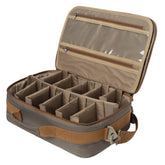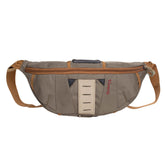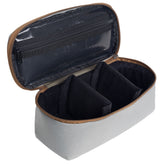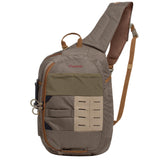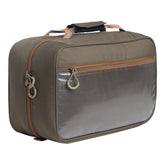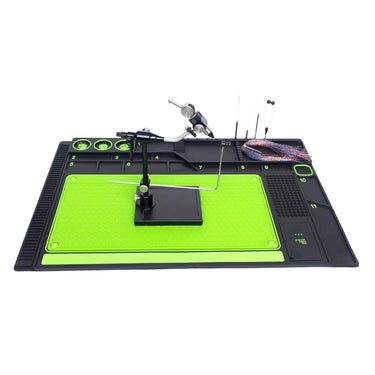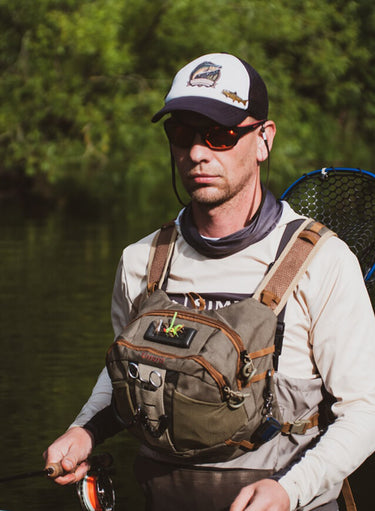Stillwater Series Part 3 (Bass Fishing in a Dam)
This stillwater fly fishing tutorial will cover all the basics you need to know to successfully catch bass in a dam. In our previous stillwater articles, we primarily focused on stillwater gear, techniques, and flies applicable to trout. Be sure to go check them out too.
There are several different bass species, like largemouth, smallmouth, and spotted, but for the purpose of this article, I’ll be treating them all the same, as I feel that most of these tactics and techniques work for most of them.
Finding Bass in a Dam
Probably the most important aspect of any style of fishing is finding the fish, and this is also super important when you’re targeting bass. One of the things you’ll hear everyone say is that bass love structure.
While this is certainly true, the questions that pop up in my mind are “What is structure?” and “When do they hang around which kind of structure?” Now, these are the right questions, as we’re diving into fish behavior.
Shallow Structure
During early spring, when water temperatures start increasing, bass migrate into shallower areas where they start to prepare themselves for the spawning season. Big females and feisty males congregate around the structure during the entire spawning season. Here, they’re usually super aggressive and territorial.
Structure types to look out for are fallen trees, submerged branches, weed beds, and so on. Work these areas during spring and you’ll definitely find fish. What I like most about targeting bass during this time is that it’s your best chance of sight fishing for these amazing creatures.
Deep Submerged Structure
If you’re not finding the bass around the normal shallow structure types, your best shot is to work deep structure. Now, if you don’t know a dam or lake very well, this might be hard to find. What you’re looking for is steep drop-offs or aquatic vegetation that’s deep.
Stillwater Bass Setup
Now that we know where to find bass, we need the right setup to catch them. The line weight rating of the setup you need to use will predominantly be influenced by the following three factors:
-
Size of the fish you’re targeting
-
Size, weight, and wind resistance of the flies you’ll be throwing at them
- How hard the wind is blowing
In most cases, dams will have bass of up to 4 pounds in weight. Here a good 6 weight rod will suffice unless you’re chucking monster Game Changers or Poppers. But, if there’s a good chance of hooking into 8 pounders or more, I recommend going for an 8wt. Obviously the line and reel need to match the rod you’re using.
When the fish are holding really deep, it might also be helpful to have a sinking line at hand. Depending on the depth you’re fishing, a di3 (which sinks 3 ips) or a di5 (which sinks 5 ips) will be your best bet. Once again, this needs to be matched to the setup you’re using.
Leader Setup
For the leader setup, I must be honest, I don’t do anything fancy or complicated. Yes, you’re welcome to go for a tapered leader, fish fluorocarbon, and all that. It certainly won’t hurt. In my case, I prefer a straight piece of mono between 8 and 10 pounds and 9ft in length.
If the fish are super-sized, I’d probably step up the breaking strain slightly, and if the fishing is super slow or you see them refuse fly after fly, go lighter.
Flies
A massive can of worms to open is which flies to use. There are literally thousands of bass fly patterns out there. I could probably write three articles just on this topic. Here I only want to cover the flies I use, and it’s basically just three patterns.
Crease Fly
The first fly I usually tie on is a Crease Fly. I wouldn’t say it gets the most eats, but when it does it’s pretty darn impressive.
What I like about the Crease Fly, compared to other poppers, is the varying actions you can get from it, from a frantic erratic dart to a solid pop.
When you’re buying them, or even better, tying them yourself, make sure that the hook gape is properly exposed to ensure good penetration.
Sex Dungeon
The Sex Dungeon is just one hell of a fly for freshwater predator species.
This thing pushes water, has incredible movement, and has two hooks, which is twice as good as one.
Wooly Bugger
It’s no secret that I’m a Woolly Bugger fan, and yes, they work extremely well for bass.
I adapt the pattern slightly when tying them specifically for bass, making the tail longer and using a suitable hook.
One of the most important, and frequently overlooked, aspects of bass flies is the hook. You’ll kick yourself if the flies aren’t tied on hooks that are suited for bass, as I’ve done many times.
Things to look for in a good bass hook are:
Must be extremely sharp
Must have a wide gape
Must have a thin wire gauge to increase penetration depth and speed
Knots
When attaching your flies to your leader, make sure to use a loop knot, which will give your flies much more movement. Some of the best knots to use here are:
Uni knot
Perfection loop
Rapala knot
Make sure you practice the knots before using them on the water.
Bass Fishing Tips and Techniques
It’s almost impossible to give you a full rundown of every aspect from delivering the fly, retrieving it, and landing a fish. For that, you need time on the water or I need to be standing right next to you helping you out in every scenario.
However, I’ve put together a list of things to keep in mind when you’re on the water next, which will help you catch more fish.
- When you deliver a cast, try to concentrate to not let go of the line completely. I see many, even experienced, anglers do this.
The problem with this is that you lose control of your fly for a brief period, and it takes a couple of seconds for you to reach forward and regain control. What if a fish eats the fly as soon as it lands? - The second tip is to take up all the slackline delivered during the cast as soon as the fly lands. This will help you detect any takes on the first drop.
- If you didn’t get a strike during your first retrieve, it doesn’t mean the fish aren’t there or they’re not hungry. I’d refish a piece of structure at least three times before moving on to the next.
- Sometimes you see a bass following the fly but not committing to eating it. Here you have a couple of options. The first is to pause, giving the fish time to inspect and eat the fly – this usually works. Sometimes it also works to pick up the speed of the retrieve to really aggravate the fish.
- Debarb your hooks, it’s better for the fish and it’s better for you.
Conclusion
I hope that you found this article helpful and that it helps you be more successful at catching bass.
Until next time.



